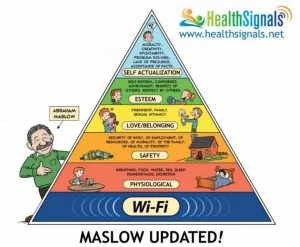 Maslow’s Hierarchy of Needs is a psychological theory outlining what we, as human beings, need to survive and thrive. For those unfamiliar with it, the model is structured as a pyramid. Our most pressing needs are the pyramid’s base, involving our physiological needs: food, water, shelter, etc. As the pyramid climbs, we reach more psychological needs: accomplishment, creativity, and so on.
Maslow’s Hierarchy of Needs is a psychological theory outlining what we, as human beings, need to survive and thrive. For those unfamiliar with it, the model is structured as a pyramid. Our most pressing needs are the pyramid’s base, involving our physiological needs: food, water, shelter, etc. As the pyramid climbs, we reach more psychological needs: accomplishment, creativity, and so on.
It’s a popular model for understanding human needs, but here’s the problem. The theory was developed by Abraham Maslow all the way back in 1943—well before the advent of tech like home computers, smartphones, or Wi-Fi. And while these gadgets might just seem like novelties, for certain populations–like continuing care retirement communities (CCRCs)—this access can save lives.
Updating Maslow: Access to Services
It’s a little tongue-in-cheek to lump Wi-Fi in there with food and water, but jokes aside, there’s a strong case for updating Maslow’s Hierarchy with access to essential tech services—particularly for CCRCs.
Senior living facilities are powered by technology. Research by Pew found that a full 67% of seniors use the internet these days, and over 51% of seniors have high-speed internet at home. And should these seniors move into assisted living facilities, you can bet that they’ll expect the same quality of life as they’re accustomed to.
And really, why wouldn’t they? They’ll still need to keep in touch with friends and family over FaceTime or Skype, and they will still need access to all of the entertainment they enjoy at home. These used to be luxuries, but today, they are essential services that every connected CCRC should offer.
This connectivity is important from a resident satisfaction standpoint, but just as important are the ways that connected facilities support better resident care. When you consider the value of connected medical facilities, it’s not a stretch at all to imagine connectivity’s place in Maslow’s Hierarchy.
Supporting Physician/Resident Relationships
Medical Grade Wi-Fi® plays a powerful role in telemedicine and the physician/resident relationship.
In one survey of U.S. physicians, 93% of those who used telemedicine applications agreed that it helped improve patient access to care, and 77% agreed that the applications helped both patient and provider better manage their time.
With the right communications tool behind them, CCRCs can ensure that their residents enjoy the benefits of high-speed internet while enabling new types of physician outreach. For example, the fast transfers offered by fiber optic Wi-Fi makes it easy for residents to call their physicians, video conference, receive/transmit medical imagery, share files, and more.
Through this approach, CCRCs can differentiate themselves (and increase occupancy rates) by positioning themselves as enhanced facilities offering a higher standard of care.
Future-Proofing With Quality Care
Telemedicine is the way the world is moving, and patients of all ages are taking advantage. CCRCs are no exception. Facility owners should take a look at their current infrastructure and what Wi-Fi enabled services they offer. We’re willing to bet there’s some room for new services—and these services may completely change the way you deliver care.
